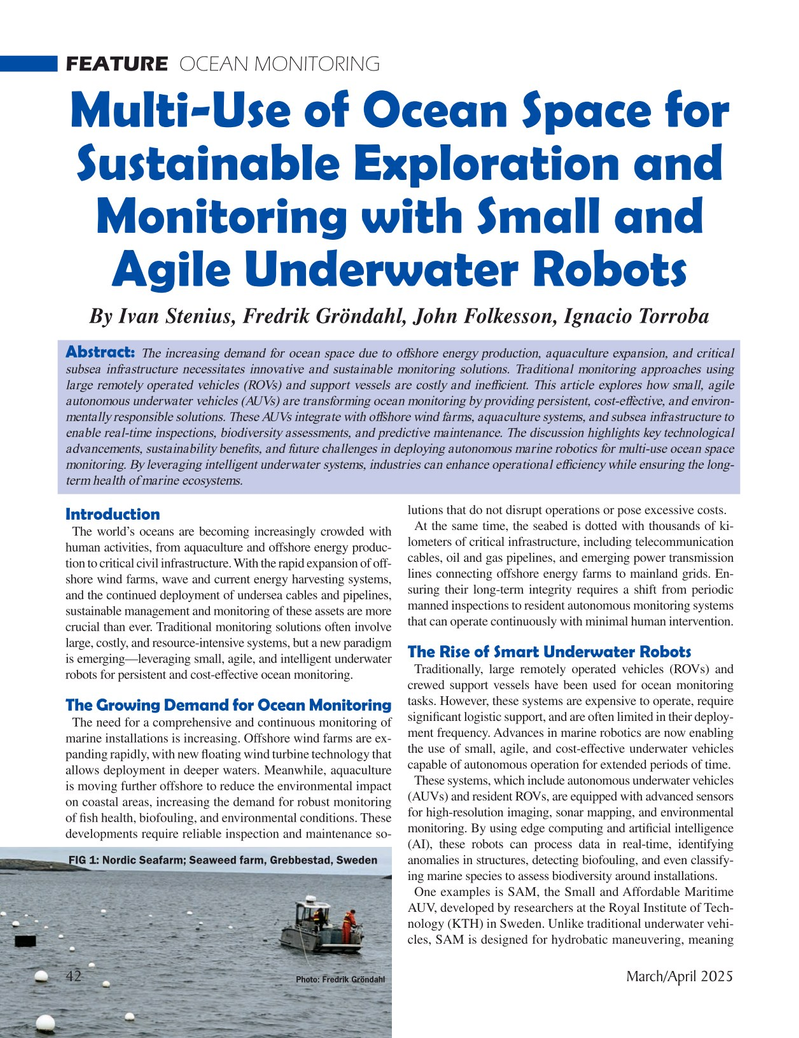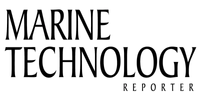
Page 42: of Marine Technology Magazine (March 2025)
Read this page in Pdf, Flash or Html5 edition of March 2025 Marine Technology Magazine
FEATURE OCEAN MONITORING
Multi-Use of Ocean Space for
Sustainable Exploration and
Monitoring with Small and
Agile Underwater Robots
By Ivan Stenius, Fredrik Gröndahl, John Folkesson, Ignacio Torroba
Abstract:
The increasing demand for ocean space due to offshore energy production, aquaculture expansion, and critical subsea infrastructure necessitates innovative and sustainable monitoring solutions. Traditional monitoring approaches using large remotely operated vehicles (ROVs) and support vessels are costly and inef? cient. This article explores how small, agile autonomous underwater vehicles (AUVs) are transforming ocean monitoring by providing persistent, cost-effective, and environ- mentally responsible solutions. These AUVs integrate with offshore wind farms, aquaculture systems, and subsea infrastructure to enable real-time inspections, biodiversity assessments, and predictive maintenance. The discussion highlights key technological advancements, sustainability bene? ts, and future challenges in deploying autonomous marine robotics for multi-use ocean space monitoring. By leveraging intelligent underwater systems, industries can enhance operational ef? ciency while ensuring the long- term health of marine ecosystems.
lutions that do not disrupt operations or pose excessive costs.
Introduction
At the same time, the seabed is dotted with thousands of ki-
The world’s oceans are becoming increasingly crowded with lometers of critical infrastructure, including telecommunication human activities, from aquaculture and offshore energy produc- cables, oil and gas pipelines, and emerging power transmission tion to critical civil infrastructure. With the rapid expansion of off- lines connecting offshore energy farms to mainland grids. En- shore wind farms, wave and current energy harvesting systems, suring their long-term integrity requires a shift from periodic and the continued deployment of undersea cables and pipelines, manned inspections to resident autonomous monitoring systems sustainable management and monitoring of these assets are more that can operate continuously with minimal human intervention.
crucial than ever. Traditional monitoring solutions often involve large, costly, and resource-intensive systems, but a new paradigm
The Rise of Smart Underwater Robots is emerging—leveraging small, agile, and intelligent underwater
Traditionally, large remotely operated vehicles (ROVs) and robots for persistent and cost-effective ocean monitoring. crewed support vessels have been used for ocean monitoring tasks. However, these systems are expensive to operate, require
The Growing Demand for Ocean Monitoring signi? cant logistic support, and are often limited in their deploy-
The need for a comprehensive and continuous monitoring of ment frequency. Advances in marine robotics are now enabling marine installations is increasing. Offshore wind farms are ex- the use of small, agile, and cost-effective underwater vehicles panding rapidly, with new ? oating wind turbine technology that allows deployment in deeper waters. Meanwhile, aquaculture capable of autonomous operation for extended periods of time.
These systems, which include autonomous underwater vehicles is moving further offshore to reduce the environmental impact (AUVs) and resident ROVs, are equipped with advanced sensors on coastal areas, increasing the demand for robust monitoring for high-resolution imaging, sonar mapping, and environmental of ? sh health, biofouling, and environmental conditions. These monitoring. By using edge computing and arti? cial intelligence developments require reliable inspection and maintenance so- (AI), these robots can process data in real-time, identifying
FIG 1: Nordic Seafarm; Seaweed farm, Grebbestad, Sweden anomalies in structures, detecting biofouling, and even classify- ing marine species to assess biodiversity around installations.
One examples is SAM, the Small and Affordable Maritime
AUV, developed by researchers at the Royal Institute of Tech- nology (KTH) in Sweden. Unlike traditional underwater vehi- cles, SAM is designed for hydrobatic maneuvering, meaning 42 March/April 2025
Photo: Fredrik Gröndahl
MTR #3 (34-49).indd 42 3/13/2025 12:38:42 PM

 41
41

 43
43
